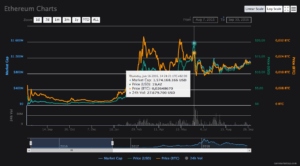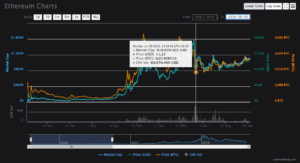Ethereum network developers are planning to launch the platform’s next hard fork called Constantinople. Prior to this there have been several updates of this platform to continue scaling the network.
In this article, you will find a brief review of the past updates of the Ethereum network, the most important features of the new update and the possible expectations after the upcoming hard fork.
The 4 Milestones of Ethereum
The launch of Ethereum network is divided into 4 milestones phases:
Phase 1 – Frontier (released): the official 1.0 release in its most minimalistic form, launched as a public main network in the summer of 2015. With the Frontier release, people could test decentralized applications (DApps) for the first time and purchase Ether to upload their own software in Ethereum. Frontier was forked to Homestead in early 2016.
Phase 2 – Homestead (released): the first major upgrade (1.1) of the Ethereum network back in March 2016, initiated after Frontier was extensively tested and classified by the core developers as stable and safe, with the purpose of stabilizing the platform.
Phase 3 – Metropolis (ongoing): the Homestead network upgrade (1.2) which was set up to be implemented in two steps: first step (Phase 3.1) is called Byzantium and was launched in October 2017 aiming to minimize fraudulent activity within the Ethereum ecosystem, increase speed, scalability, smart contract efficiency and to secure a more effective and safe infrastructure for DApps. The second step (Phase 3.2) Constantinople, the next Ethereum network hard fork.
Phase 4 – Serenity (upcoming): the final phase of the network. Ethereum is based in a Proof of Work (PoW) consensus algorithm (Ethash) that entails an enormous waste of energy and because of this, the developers want to find an alternative, which is expected to convert the current PoW algorithm to Proof of Stake (PoS) optimizing the energy consumption of the network (green techs). Additionally, the network should be faster, more efficient, easier for beginners and more resilient against the closure of mining capacity.
The next Ethereum hard fork: Constantinople
Constantinople is the upcoming Ethereum hard fork, the second step (Phase 3.2) of the Metropolis network and its activation will make the mainnet cheaper and more efficient. This phase is primarily designed to be the final half of the protocol upgrade that aims to smooth the transition from a PoW consensus algorithm to PoS.
Constantinople key factors:
- Was announced on July 27th, 2018 by Ethereum developers.
- The network activation is scheduled for October 30th, 2018, before the October Devcon4 Ethereum conference.
- The exact block number has not yet been confirmed in which the code would become operational.
- The Ethereum developers have already implemented most of the Ethereum Improvement Proposals (EIPs).
What to expect from Constantinople hard fork?
Constantinople paves the way for a more efficient version of the Ethereum network and, with a successful hard fork, the ecosystem of this platform is set to be more mature.
Furthermore, community and investors will always be very attentive to the news that develops after the hard fork is implemented as controversial situations may arise, such as the one that occurred in July 2016, in which the hard fork implemented created the Ethereum Classic network. This occurred in part due to a $50 million (3.6 million Ether) Ethereum network hack (The DAO hack) that showed a lack of security in the network. This caused a drop in the price of almost half its value at the time.


Generally, these updates do not have problems since they are hard-tested by the developers before being implemented. If the upgrade improves the scalability and adoption of the technology, it is very likely that it can be well received by future investors and developers. It should be noted that Ether (ETH) reached a historical high of $1,343 in January 2018 and by the end of July 2018, it had lost at least 3 times its value.

















